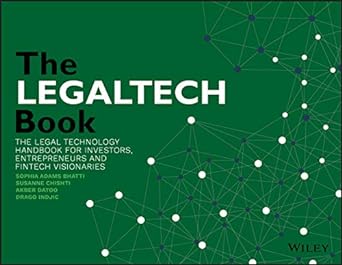Answered step by step
Verified Expert Solution
Question
1 Approved Answer
1.Use Exhibit TN4 spreadsheet. How would your analysis in no tax situation change if 20% corporate tax is implemented? Please note that, with corporate taxes,
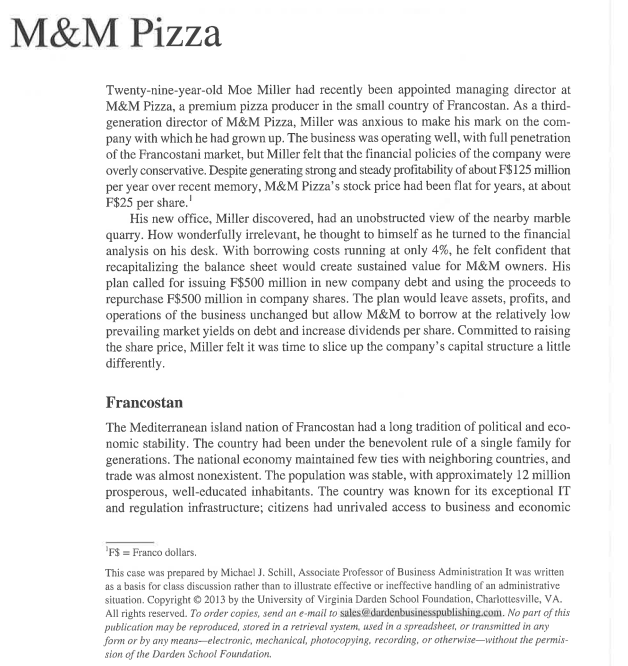
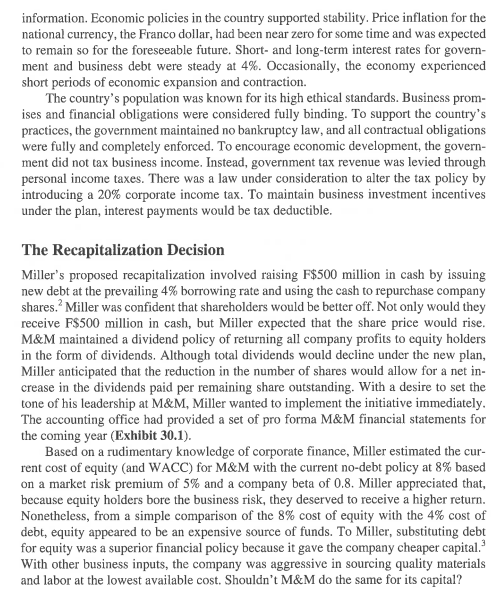
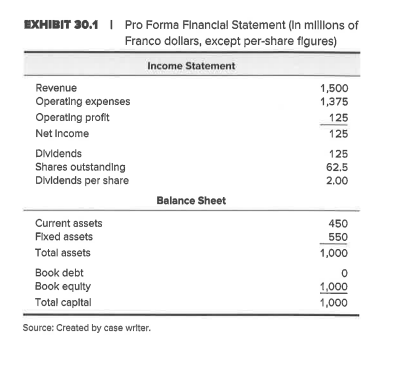
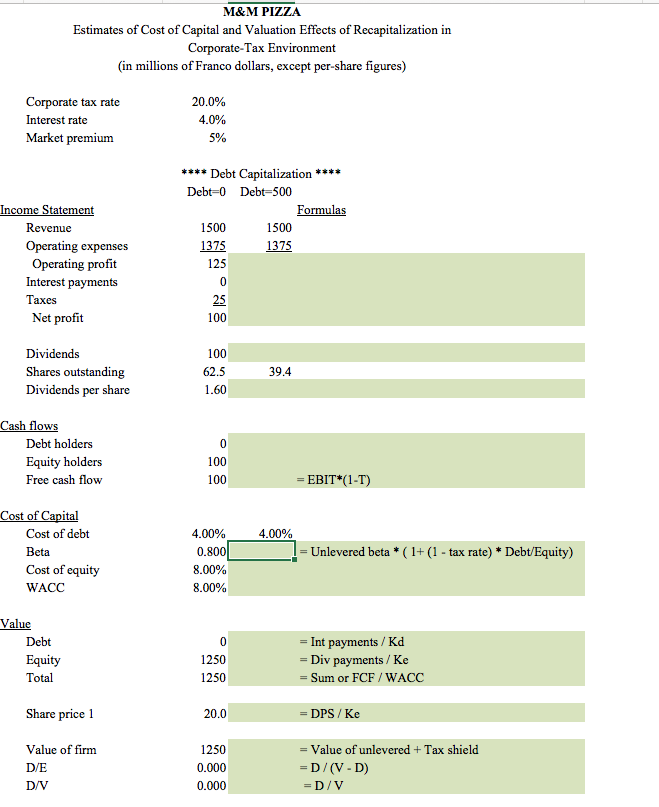
1.Use Exhibit TN4 spreadsheet. How would your analysis in no tax situation change if 20% corporate tax is implemented? Please note that, with corporate taxes, the expected debt-to-equity ratio under the share repurchase plan is 0.588, and the number of remaining shares outstanding is 39.4 million.
2.What impact does the repurchase plan have on M&Ms weighted-average cost of capital, share price and firm value? Is it what you expected?
information. Economic policies in the country supported stability. Price inflation for the national currency, the Franco dollar, had been near zero for some time and was expected to remain so for the foreseeable future. Short- and long-term interest rates for govern- ment and business debt were steady at 4%. Occasionally, the economy experienced short periods of economic expansion and contraction. The country's population was known for its high ethical standards. Business prom- ises and financial obligations were considered fully binding. To support the country's practices, the government maintained no bankruptcy law, and all contractual obligations were fully and completely enforced. To encourage economic development, the govern- ment did not tax business income. Instead, government tax revenue was levied through personal income taxes. There was a law under consideration to alter the tax policy by introducing a 20% corporate income tax. To maintain business investment incentives under the plan, interest payments would be tax deductible The Recapitalization Decision Miller's proposed recapitalization involved raising F$500 million in cash by issuing new debt at the prevailing 4% borrowing rate and using the cash to repurchase company shares. Miller was confident that shareholders would be better off. Not only would they receive F$500 million in cash, but Miller expected that the share price would rise M&M maintained a dividend policy of returning all company profits to equity holders in the form of dividends. Although total dividends would decline under the new plan, Miller anticipated that the reduction in the number of shares would allow for a net in crease in the dividends paid per remaining share outstanding. With a desire to set the tone of his leadership at M&M, Miller wanted to implement the initiative immediately The accounting office had provided a set of pro forma M&M financial statements for the coming year (Exhibit 30.1). Based on a rudimentary knowledge of corporate finance, Miller estimated the cur- rent cost of equity (and WACC) for M&M with the current no-debt policy at 8% based on a market risk prem! urn of 5% and a company beta of 0.8. Miller appreciated that, because equity holders bore the business risk, they deserved to receive a higher return. Nonetheless, from a simple comparison of the 8% cost of equity with the 4% cost of debt, equity appeared to be an expensive source of funds. To Miller, substituting debt for equity was a superior financial policy because it gave the company cheaper capital With other business inputs, the company was aggressive in sourcing quality materials and labor at the lowest available cost. Shouldn't M&M do the same for its capital? EXHIBIT 30.1 Pro Forma Flnanclal Statement (In millons of Franco dollars, except per-share figures) Income Statement 1,500 1,375 125 125 Revenue Operating expenses Operating profit Net Income 125 62.5 2.00 Shares outstanding Dlvldends per share Balance Sheet 450 550 1,000 Current assets Fixed assets Total assets Book debt Book equlty Total capltal 1,000 1,000 Source: Created by case writer M&M PIZZA Estimates of Cost of Capital and Valuation Effects of Recapitalization in (in millions of Franco dollars, except per-share figures) Corporate tax rate Interest rate 20.0% 4.0% 5% Market premium Debt Capitalization**** Debt-0 Debt-500 1500 1375 Revenue 1500 1375 125 Operating expenses Operating profit Interest payments 25 100 Net profit 100 62.5 1.60 Dividends Shares outstanding Dividends per share 39.4 Debt holders Equity holders Free cash flow 100 100 EBIT*( 1-T) 4.00% 0.800 8.00% 8.00% 4.00% Cost of debt Beta Cost of equity WACC Unlevered beta * (1+ (1 - tax rate) * Debt/Equity) Value Debt Equity Total Int payments/Kd Div payments/Ke Sum or FCF / WACC 1250 1250 DPS/Ke Share price 1 20.0 Value of firm D/E D/V 1250 0.000 0.000 -Value of unlevered +Tax shield D/(V- D) D/V information. Economic policies in the country supported stability. Price inflation for the national currency, the Franco dollar, had been near zero for some time and was expected to remain so for the foreseeable future. Short- and long-term interest rates for govern- ment and business debt were steady at 4%. Occasionally, the economy experienced short periods of economic expansion and contraction. The country's population was known for its high ethical standards. Business prom- ises and financial obligations were considered fully binding. To support the country's practices, the government maintained no bankruptcy law, and all contractual obligations were fully and completely enforced. To encourage economic development, the govern- ment did not tax business income. Instead, government tax revenue was levied through personal income taxes. There was a law under consideration to alter the tax policy by introducing a 20% corporate income tax. To maintain business investment incentives under the plan, interest payments would be tax deductible The Recapitalization Decision Miller's proposed recapitalization involved raising F$500 million in cash by issuing new debt at the prevailing 4% borrowing rate and using the cash to repurchase company shares. Miller was confident that shareholders would be better off. Not only would they receive F$500 million in cash, but Miller expected that the share price would rise M&M maintained a dividend policy of returning all company profits to equity holders in the form of dividends. Although total dividends would decline under the new plan, Miller anticipated that the reduction in the number of shares would allow for a net in crease in the dividends paid per remaining share outstanding. With a desire to set the tone of his leadership at M&M, Miller wanted to implement the initiative immediately The accounting office had provided a set of pro forma M&M financial statements for the coming year (Exhibit 30.1). Based on a rudimentary knowledge of corporate finance, Miller estimated the cur- rent cost of equity (and WACC) for M&M with the current no-debt policy at 8% based on a market risk prem! urn of 5% and a company beta of 0.8. Miller appreciated that, because equity holders bore the business risk, they deserved to receive a higher return. Nonetheless, from a simple comparison of the 8% cost of equity with the 4% cost of debt, equity appeared to be an expensive source of funds. To Miller, substituting debt for equity was a superior financial policy because it gave the company cheaper capital With other business inputs, the company was aggressive in sourcing quality materials and labor at the lowest available cost. Shouldn't M&M do the same for its capital? EXHIBIT 30.1 Pro Forma Flnanclal Statement (In millons of Franco dollars, except per-share figures) Income Statement 1,500 1,375 125 125 Revenue Operating expenses Operating profit Net Income 125 62.5 2.00 Shares outstanding Dlvldends per share Balance Sheet 450 550 1,000 Current assets Fixed assets Total assets Book debt Book equlty Total capltal 1,000 1,000 Source: Created by case writer M&M PIZZA Estimates of Cost of Capital and Valuation Effects of Recapitalization in (in millions of Franco dollars, except per-share figures) Corporate tax rate Interest rate 20.0% 4.0% 5% Market premium Debt Capitalization**** Debt-0 Debt-500 1500 1375 Revenue 1500 1375 125 Operating expenses Operating profit Interest payments 25 100 Net profit 100 62.5 1.60 Dividends Shares outstanding Dividends per share 39.4 Debt holders Equity holders Free cash flow 100 100 EBIT*( 1-T) 4.00% 0.800 8.00% 8.00% 4.00% Cost of debt Beta Cost of equity WACC Unlevered beta * (1+ (1 - tax rate) * Debt/Equity) Value Debt Equity Total Int payments/Kd Div payments/Ke Sum or FCF / WACC 1250 1250 DPS/Ke Share price 1 20.0 Value of firm D/E D/V 1250 0.000 0.000 -Value of unlevered +Tax shield D/(V- D) D/VStep by Step Solution
There are 3 Steps involved in it
Step: 1

Get Instant Access to Expert-Tailored Solutions
See step-by-step solutions with expert insights and AI powered tools for academic success
Step: 2

Step: 3

Ace Your Homework with AI
Get the answers you need in no time with our AI-driven, step-by-step assistance
Get Started


